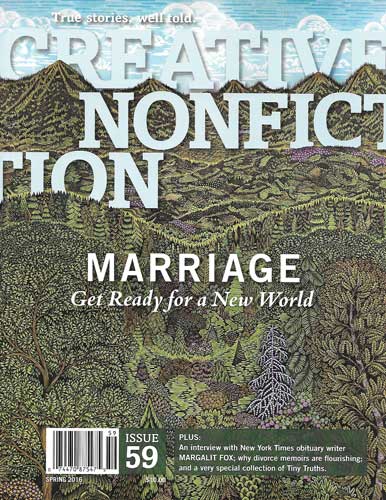Creative Nonfiction – Spring 2016
This issue of Creative Nonfiction focuses on the sacrament of marriage. But if you think you’re in for an issue of romantic tales and happily-ever-afters, keep in mind that this magazine is nonfiction. While the wedding itself and much of a marriage can be happy, real life happens, and like anything lasting or worthwhile, it has its ups and downs. This issue explores many angles of marriage including “non-traditional” marriages, spur-of-the-moment marriages, fifth marriages, same-sex marriages, marriages that work, those that don’t. Paul Roden and Valerie Lueth’s (of Tugboat Printshop) beautiful and intricate woodcut prints are featured throughout the issue to tie it all together.
This issue of Creative Nonfiction focuses on the sacrament of marriage. But if you think you’re in for an issue of romantic tales and happily-ever-afters, keep in mind that this magazine is nonfiction. While the wedding itself and much of a marriage can be happy, real life happens, and like anything lasting or worthwhile, it has its ups and downs. This issue explores many angles of marriage including “non-traditional” marriages, spur-of-the-moment marriages, fifth marriages, same-sex marriages, marriages that work, those that don’t. Paul Roden and Valerie Lueth’s (of Tugboat Printshop) beautiful and intricate woodcut prints are featured throughout the issue to tie it all together.
Elaine Johnson’s “The Math of Marriage,” winner of the Best Essay Prize, artfully uses statistics about marriage to draw a picture of what marriage looks like today, pairing this alongside the story of “your fifth marriage.” Despite the statistics and the warnings of the world, in the end, Johnson emphasizes the equation that matters: “1/2 + 1/2 = one.” The writing doesn’t leave room for judgment on the topic, and the second-person point of view allows readers to consider themselves in their own situations.
Jeff Oaks uses the alphabet form to tell about the first year of his marriage. While I don’t think the form is entirely necessary, the essay offers wonderful imagery and word play I can’t help but adore. For example, the vignette “On Bread” uses yeasty words to show the fear of growing bigger ‘round the middle the more comfortable a couple becomes with one another: “At night, after the gym, we knead each other’s sore muscles. We rise up again and again. We worry about becoming doughy . . . ” My favorite bit of advice he offers is, “Find the one you can fart freely with and still love completely, and you’ve found your future.”
One of the standout pieces in this selection is Melissa Shepherd’s “That Night: Fifty Years Later,” which starts out immediately with her boyfriend popping “the question.” It was sooner than they had discussed, but on August 26, 1965, President Lyndon Johnson declared that men married after midnight of that day would no longer be deferred from the draft. So they spur-of-the-moment set out on a complicated journey to be married that night to avoid him going to Vietnam. The story almost writes itself with great stakes and a time limit, and was written in a way that I was right alongside cheering them on. But it’s really the small details that Shepherd includes that enhance the overall story: the information about the draft, descriptions of the era, and the historical context. “According to the Thurston Clarke article, the lowest official estimate of marriages on that day was 20,000, but that number was a record for weekday marriages . . . and for marriages performed between 9 PM and midnight.”
The issue ends with excerpts from Matthew G. Miller’s Twitter. Yes, you read that correctly. For two years, he tweeted daily about the unfolding of his relationship. In an experimental art form, he divulges truth in short segments that certainly use the character limit to the advantage: “When did our relationship end? Could be when she switched from saying ‘Stop being a jerk’ to ‘Never mind’” and “My son spends half of dinners, of evenings, of breakfasts at his mother’s. I now spend half my life waiting for the other half,” for examples.
There is much to love about this special marriage themed issue of Creative Nonfiction. It feels strongly cohesive and offers an incredible range in views and types of marriages addressed without lacking anything for quality. There is not a piece in this issue I wouldn’t read again.
[www.creativenonfiction.org]





